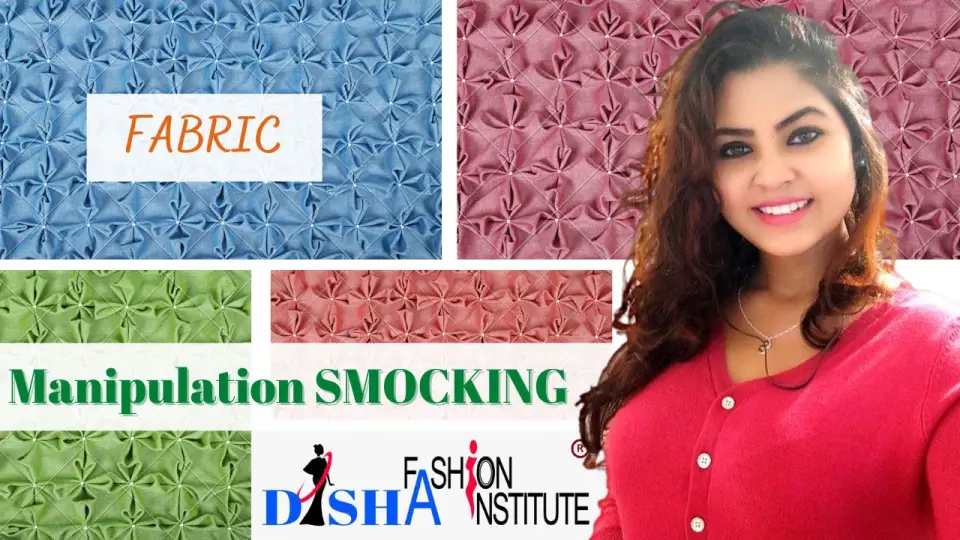The Basics of Fabric Manipulation Smocking: Everything You Need to Know
What is Fabric Manipulation Smocking?
If you are familiar with sewing and embroidery, you may have heard of fabric manipulation smocking. Fabric smocking is a technique used to gather fabric so that it can be fitted more closely to the body. Historically, before the use of elastic, the gather used to be done on the fabric to give an elastic effect. It is called smocking when decorative embroidery stitches are done on the top of the gather. This is called regular smocking. There is another type of smocking called Canadian smocking which is much different than regular smocking. We will discuss everything in details in this blog post.
Smocking is often used on children's clothing, but can be used on adult clothing as well. Fabric smocking can be done by hand or by machine. The name "smocking" comes from the Old English word smoc, which means "to embroider." Canadian smocking is a variation of this traditional needlework that uses a special stitch to create different pattern on the fabric. In this blog post, we will touch base all topics related to Fabric Manipulation Smocking.
Table of Contents:
- What is Fabric Manipulation Smocking?
- Types of Fabric Manipulation Smocking
- How to make smocked fabric
- How to Smock Fabric by Hand
- How to Smock Fabric Using Machine
- Best Fabric for Smocking
- List of Certificate Courses offered by Disha Fashion Institute
- Other Topics
Types of Fabric Manipulation Smocking
In general, you can classify smocking in two basic types. Regular smocking and Canadian smocking. Please note that, these two types of smocking are totally different in nature.
Regular Smocking
The regular smocking is one type of embroidery stitching. To make a smocked fabric, at first the fabric is gathered using any fabric gathering techniques. At this stage it is nothing but gathered fabric. When embroidery stitches or any type of decorative stitches are done on the top of the gather, it is called fabric smocking.
Canadian Smocking
This unique form of needlework is often used to decorate clothing and other household items. Canadian smocking typically features a geometric design, and the stitches are worked in a specific order to create the desired pattern.
A Brief History of Canadian Smocking
The art of smocking has been around for centuries and can be seen in a variety of cultures. The Canadian version of smocking is a relatively recent development, but has quickly become a popular way to decorate clothing.
The history of Canadian smocking can be traced back to the early 20th century, when a group of women in Halifax, Nova Scotia decided to start a smocking club. These women were interested in the traditional English smocking techniques, but adapted them to create their own unique style.
Since then, Canadian smocking has evolved and become more refined. Today, there are many different smocking stitches and patterns that can be used to create beautiful garments. Canadian smocking is a popular way to add a personal touch to clothing, and is often used to create heirloom-quality items.
The difference between Canadian Smocking and Regular Smocking
They are quite different.
- The regular smocking was historically used to create an elastic effect. On the contrary the Canadian smocking does not serve that purpose.
- In the regular smocking, the fabric is pleated or gathered and then decorative stitches are done on top of that to create different types of pattern which will make the design attractive. So the stitches are visible on the front. Basically the decorative stitches or the embroidery is the main part of the smocking design. On the other hand, in Canadian smocking method, no stitches or thread will be visible on the front. The design is made by the special types of gather itself.
- According to the above point, the regular smocking is done from the front and the Canadian smocking is worked from the back.
When we will show you different types of regular and Canadian smocked fabric you will have clear understanding on smocking.
How to make smocked fabric
Smocking is done by hand or by machine. Hand smocking is the more traditional method and is done by stitching rows of pleats into the fabric. The fabric is then gathered together using a needle and thread.
Machine smocking is done using a special machine that has a needle and thread that work together to create the pleats in the fabric. This method is faster and can be done on a wider range of fabrics.
Smocking is a great way to add a bit of decoration to a garment. It can also be used to make a garment more fitted. If you are interested in learning how to smock, there are many resources available online and in sewing books.
How to Smock Fabric by Hand
Whether you're looking to add a decorative touch to a garment or simply want to try your hand at a new sewing technique, smocking is a great option. While it may seem like a daunting task, smocking fabric by hand is actually quite simple. With a little patience and practice, you'll be able to create beautiful smocked fabric in no time.
Regular Fabric Smocking Techniques
Here we will teach you two simple method of Regular Fabric Smocking
Regular Fabric Smocking Technique 1
The fabric can be gathered by making a running stitch, keeping the thread loose, and tightening the thread at the end. You can use some decorative items in the thread to make the gather more beautiful. This is a simple type of fabric smocking where the decorations are done by inserting decorative items in the gathering thread. You can watch the below video to understand the process.
Regular Fabric Smocking Technique 2
You can make the simple gather on the fabric and do embroidery stitches after that to smock the fabric. Watch the following video to understand the process.
Canadian Smocking Tutorial Step by Step
There are different types of Canadian Smocking Techniques.
Wave Pattern Canadian Smocking
The wave pattern is a type of Canadian smocking that is made by working a series of stitches over a row of pins. This type of smocking is often used to decorate the yoke of a dress or the bodice of a blouse.
The following video contains the process of doing Wave Pattern Canadian Smocking, Lattice Pattern Canadian Smocking and Heart Pattern Canadian Smocking.
Lattice Pattern Canadian Smocking
Lattice pattern smocking is a beautiful way to decorate fabric, and it can be used to add a special touch to clothing, quilts, and other items.
Heart Pattern Canadian Smocking
Heart pattern Canadian smocking is a relatively simple form of needlework that can be used to create a variety of different patterns and designs. It is an ideal way to add a personal touch to clothing, and can be worked in a variety of different colors and threads to suit any preference.
Flower Pattern Canadian Smocking
Flower Pattern Canadian Smocking is a form of needlework that is often used to decorate clothing. It is a type of embroidery that uses a needle and thread to create a raised, three-dimensional design on fabric. This type of smocking is often used to decorate children's clothing, as the raised flowers add a touch of whimsy and elegance to the garments. Canadian smocking is a relatively easy form of needlework to learn, and it can be a fun and creative way to add your own personal touch to clothing.
Leaf Pattern Canadian Smocking
When it comes to smocking, there are a variety of different techniques that can be used. One of these is Leaf Pattern Canadian Smocking, which is a form of needlework that is typically used to decorate clothing.
This type of smocking is usually done on fabric that has been starched, and the process involves creating small, raised stitches in a variety of different directions. This creates a raised, leaf-like pattern on the fabric that can be quite striking.
Leaf Pattern Canadian Smocking is a beautiful way to add a touch of decoration to clothing, and it can be used to create a variety of different looks. If you're interested in learning this technique, please watch the below video.
Bricks Pattern Canadian Smocking
Bricks Canadian smocking is the type of Canadian smocking where the thread and needlework is used to create a raised, bricks like pattern on the fabric.
Tubes Pattern Canadian Smocking
Tubes Canadian smocking is the type of Canadian smocking where the thread and needlework is used to create a raised, Tube like pattern on the fabric. You can follow the stitching pattern shown in the picture below to create the tube style smocking in the fabric.
The following pattern can also be used to make tube style smocking.

Watch the below video and follow the instructions to make tube style Canadian smocking.
Bones Pattern Canadian Smocking
This is another variety of Canadian Smocking. Generally the crisscross style is used in the bones pattern Canadian smocking. You can follow the design drawn in the below image. The image of the end result of the design is also given. You can also check the YouTube video and follow each steps described to make an attractive crisscross bones pattern on the fabric.
How to Smock Fabric Using Machine
The Canadian smocking cannot be done using machine. The Canadian smocking can only be done using your hands.
But regular smocking can be done using both by hand or machine. Both have their pros and cons, so it's important to choose the right method for your project.
Machine smocking is faster and more consistent, but it can be more expensive and it can be difficult to achieve complex designs. Hand smocking is slower and more labour intensive, but it's cheaper and it allows for more creative freedom.
So, which is the best method? It depends on your needs. If you're looking for speed and consistency, machine smocking is the way to go. If you're on a budget or you want to be able to create more complex designs, hand smocking is the better option.
Following is a video showing fabric smocking process using a sewing machine.
Best Fabric for Smocking
When it comes to smocking, there are a few things you need to take into consideration. The first, and arguably most important, is the fabric you use.
- First of all, I would recommend to start with a 100 percent cotton fabric.
- The second is the weight of the fabric. I would recommend using a light- to medium-weight fabric.
- The third is the pattern of the fabric. I would recommend using a fabric with a small print or a solid-color fabric.
List of Certificate Courses offered by Disha Fashion Institute
| Tailoring Course Name | Duration | Admission Fee | Monthly Fee | Syllabus |
| Diploma in Sewing and Designing | 6 Months | 530/- | 700/- | Basic Tailoring Course |
| Diploma in Dress Designing | 9 Months | 900/- | 1000/- | Advanced Tailoring Course |
| Blouse Designing Course | 4 Months | 1000/- | 1200/- | Blouse Designing Course |
| Kurti Designing Course | 4 Months | 1000/- | 1200/- | Kurti Designing Course |
![[DISHA] The Best Tailoring School](/media/plg_jspeed/cache/images/Disha_logo.webp)







